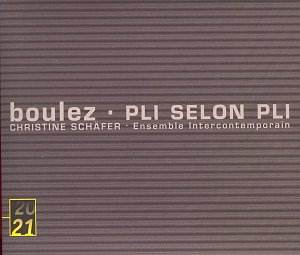Paul Griffiths promises us in his sleeve notes to this,
Boulez’s third recording of Pli selon pli, that the disc contains
‘The ultimate realization [sic]’, the ‘definitive shape’ of his portrait
of Stephane Mallarmé. Elsewhere, this 1989 version of a piece
more than three decades in the creating and refining is described only
as its ‘present version’. Given the composer’s penchant - some might
say obsession - for revising earlier works, this might seem a wiser
hedging of bets. In all truth, though, Boulez will probably leave it
be, if for no more pragmatic reason than that he has plenty else to
do - returning to Bayreuth for Parsifal next summer and ‘recomposing’
more of the piano Notations for orchestra being near the top
of the list that also includes a violin concerto for Anne-Sophie Mutter.
To the two ‘Improvisations sur Mallarmé’ from
1957, Boulez added a third and then two larger-scale bookends, Don
and Tombeau, within the next four years. By 1962, he had increased
the instrumentation of the first two Improvisations to match
the rest, and that version was the basic text for his first two recordings
of the work, made in 1969 and 1982. Griffiths describes the forces required
as a soprano with a ‘medium-scale orchestra’: the effect, though, is
one of a hyper-varied chamber ensemble, capable even of more subtleties
of timbre and rhythm than a full symphony orchestra. Boulez thought
otherwise, for the 1989 revision enlarges the third improvisation in
scale and content and makes solid the previously fluid order of certain
sections.
Is it basically the same piece? Yes. In which case,
should you care what tinkerings happened when? Well, yes. Paradoxically,
the two previous recordings of Pli selon pli, using smaller forces,
were made with the BBC Symphony Orchestra; this one is played by the
Ensemble Intercontemporain, ‘his ideal interpreters’, DG trumpets, who
when I saw them perform the work at the Royal Festival Hall a couple
of years ago, filled the stage. The ensemble certainly displays greater
familiarity with the music and more security with its extreme rhythmic
virtuosity but even the relatively minor increase in the density of
texture makes what is already formidably complex music more bewildering
to listen to.
That said, the recording makes things as delightful
for the listener as is conceivably possible. DG has created a soundstage
of remarkable depth and fidelity: the guitar, mandolin and piano which
play such an important part in this music, at once percussive and sensuous,
are placed at realistic distances from each other. Every instrument
seems to emerge from the speakers in its own place. Erato’s sound for
the second recording is what lets it down most, losing clarity at complexes
of loud drum strokes.
As if to further compensate for the extra elaboration
of the musical ‘folds’, Boulez has also slackened his tempos over the
three recordings: this one is a full ten minutes longer than the Sony
recording. It’s hard to say whether this makes the soprano role more
or less taxing; Christine Schafer is more tonally beguiling than Halina
Lukomska on Sony or Phyllis Bryn-Julson on Erato, but pretty sounds
aren’t everything; the other two both also inflect Mallarmé’s
elusive text with considerable understanding. Bryn-Julson’s vibrato
grates on me after repeated listening, but Lukomska offers a slightly
plainer interpretation that gives more of a conventional phrase structure
to her singing.
This new DG recording offers the most complex and detailed
recording yet of a piece still puzzling and profoundly beautiful. But
complexity isn’t everything; those who already know and love the work
will want to hear to hear it, but for the newcomer to Boulez, I recommend
going back to his (almost ) first thoughts on the matter, on Sony.
Peter Quantrill


